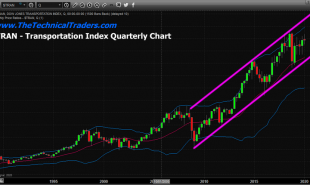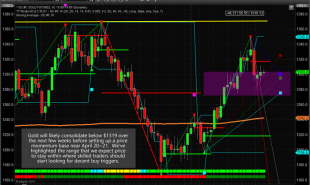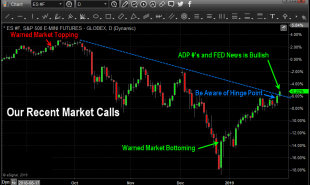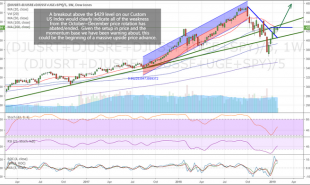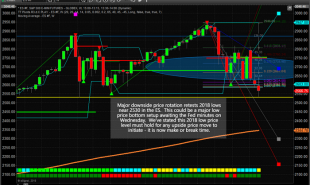
Blow.Off.Top.
by Sven Henrich via NorthmanTrader.com,
No period is worse for bears than when it’s the best time to sell stocks. It’s the polar opposite of when conditions are worst for bulls, right when it’s the best time to buy as it was in January-March 2009. The exhaustion factor is enormous. It’s called capitulation as moves get stretched to the extreme even though the set-up is valid.
November’s close marked the 13th consecutive month straight up for global markets. Nothing but up with fewer and ever smaller dips in between. Deutsche Bank’s Reid illustrated the point: “We’ve never had such a run with data going back over 90yrs”. I’d say that qualifies as the worst of time for bears.
Yet we could be sitting on a generational opportunity to sell equities as it could be argued that conditions will never be better for bulls as the game of offering carrots of free money is coming to an end. Indeed it could be argued that the prospect of tax cuts is the final carrot the free money scheme has to offer. The carrot top. No more carrots.
Consider the central banking liquidity game has peaked and is dropping off:
The 2016/2017 period saw the largest amount of central bank intervention ever. Ever. Over 8 years after the financial crisis.
The slow reduction in central bank liquidity has been supplemented by record ETF inflows this year. Retail went long and continues to buy the most expensive market since 1900 according to Goldman:
Even now via @jennablan: “U.S.-based money market funds attract inflows of $33 bln in week ended nov 29, largest inflows for the year”.
And leverage has never been higher either. Via @Schuldensuehner:
“Dow Jones Industrial closed >24k for the first time ever. Wall St record has occurred in tandem w/record margin debt. Margin debt now at $561bn, double amount of tech bubble of 2000, 47% > than in 2007”:
Retail is in and we see it in various data charts:
Via @BN:
The Rydex bull/bear allocation data shows the most bullish allocation into equities ever:
Don’t tell me it’s the most hated bull market ever. The data says otherwise.
Markets are in big time pig time mode. The prospect of imminent tax cuts keeps investor salivating and allocating cash into all time highs as markets drenched in 8 years of artificial liquidity find tax cuts to be the next carrot to push markets caps into the stratosphere:
A blow-off top perhaps setting us up us for something more sinister than a correction. What’s the biblical phrase? Forgive them for they do not know what they are doing?
Look, the tax narrative is that tax cuts will pay for themselves, that companies will hire more people as a result, and that middle class will benefit greatly from it, that GDP will swell to 4% and Trump claimed that these tax cuts will actually personally hurt himself financially. None of these things are true. Not a one. In fact everything is precisely the opposite. The math says so.
While extreme political tribalism encourages ideology over facts math is true whether you believe in it or not. And these tax cuts will add greatly to the deficits. I won’t belabor the point here as I’ve outlined my thoughts on the subject in detail in Tax Cut Scam.
An Opinion Piece From The Edge: Tax Cut Scam. This tax cut proposal is a scam. Don't fall for it.https://t.co/rkDg5UnIZ3 pic.twitter.com/L9lhIqd9sn
— Sven Henrich (@NorthmanTrader) November 9, 2017
The deficit will increase, many will see actual tax increases over time and/or lose benefits and the big tax cut benefits go precisely to people such as Trump and corporations already sitting on record cash positions. As far as GDP growth the FOMC doesn’t believe it either as incoming Fed Chair Powell affirmed a 2.5% GDP outlook for 2018 and many companies are on the record that they will use the extra cash for dividends and buybacks not hiring. This tax bill will exacerbate wealth inequality.
And hiring? Forget it. Structurally we’re looking at the great firing to come: 800 million people might be out of a job by 2030 because of automation
Precise numbers are to be taken with a grain of salt but it’s coming, whether you want to believe it or not.
And this perhaps is the biggest lie of the entire construct: That it’s done for the benefit of the middle class. It’s not. It’s done for wealthy donors who have threatened to cut off donations if they don’t see results. It’s big time pig time. Greed at its finest consequences be damned.
So the odds are the tax cut bill will end up passing in one form or another unless someone stands up and says they’re not voting for something that’s based on a lie.
Deficits will keep expanding before even a new recession hits. I’ve said for a long time that market levels and economic growth have been bought with debt and stimulus producing multiple expansion. See below multiple expansion in context of price and aggregate GAAP earnings:
We do not know what organic growth is without permanent intervention. That was true with the past administration and it is true with this one.
Except now we see increased in defense spending and a cutting of the revenue structure. This year’s deficit was already $666B and that’s without tax cuts. The deficit will be expanding to $900B by 2019 according to JPMorgan.
Even Janet Yellen felt compelled to comment on the debt:
“I would simply say that I am very worried about the sustainability of the U.S. debt trajectory,” Yellen said.
“It’s the type of thing that should keep people awake at night,” she added.”
Cute, especially coming from her who was a key contributor to the easy money train. The context is glaringly obvious:
Janet Yellen: “It’s the type of thing that should keep people awake at night” pic.twitter.com/PsRUHVpbH5
— Sven Henrich (@NorthmanTrader) November 30, 2017
But Janet Yellen is not alone in suddenly getting concerned about the sustainability of debt expansion.
Dallas Fed president Kaplan came out this week and basically highlighted many of the concerns I’ve been talking about for a long time. A shockingly rare admission of the truth. Quite a statement:
“As a central banker, I want to be vigilant to imbalances and distortions that can build as a result of accommodative monetary policy. I have argued that monetary policy accommodation is not “free” —there are costs to accommodation in the form of distortions and imbalances in consumer decisions as well as in investing, hiring and other business decisions. More specifically, experience suggests that the greater the overshoot of full employment, the more difficult it is to unwind imbalances when growth ultimately slows—as it certainly must.
When excesses ultimately need to be unwound, this can result in a sudden downward shift in demand for investment and consumer-related durable goods. There are surprisingly few historical examples of “soft landings” in cases where employment has risen above its maximum sustainable level.
It is of course possible that “this time will be different,” but as I assess the condition of the U.S. economy, I am carefully monitoring evidence that might suggest growing risks of real imbalances, which could threaten the sustainability of the current economic expansion. For example, the headline unemployment rate has fallen by 70 basis points over the past year, nearly matching the average rate of decline over the prior seven years of the expansion. If this rate of decline continues, this will further tighten labor market conditions and would likely add to excesses and imbalances accumulating in the economy.
Excesses can also manifest themselves in financial imbalances. While I would prefer to rely primarily on macroprudential policy tools to manage financial imbalances, I am nevertheless monitoring various measures of potential financial excess. I monitor these and other market measures because I am aware that, as excesses build, we are more vulnerable to reversals which have the potential to cause a rapid tightening in financial conditions, which in turn, can lead to a slowing in economic activity. Examples of potential excesses might include:
- The U.S. stock market capitalization now stands at approximately 135 percent of GDP, the highest since 1999/2000.[3]Correspondingly, commercial real estate cap rates and valuation measures of debt and other markets appear notably extended.
- Measures of stock market volatility are historically low.[4] We have now gone 12 months without a 3 percent correction in the U.S. market.[5] This is extraordinarily unusual.
- While household debt to GDP has improved over the past eight years, corporate debt is now at record highs.[6] I am not overly concerned about current levels of corporate debt because, importantly, financial sector leverage has declined substantially since the Great Recession. However, U.S. government debt now stands at approximately 75 percent of GDP,[7] and the present value of unfunded entitlements now stands at approximately $49 trillion.[8] In my view, the projected path of U.S. government debt to GDP is unlikely to be sustainable—and has been made to appear more manageable due to today’s historically low interest rates.
- Debt and equity securities trading volumes have markedly declined over the past several years. For example, NYSE equity trading volume on average for 2017 is down 51 percent from 2007 levels, while the NYSE market cap has increased 28 percent over the same time period.[9] I would also note that margin debt is now at record-high levels.[10] In the event of a sell-off, high levels of margin debt can encourage additional selling, which could, in turn, lead to a more rapid tightening of financial conditions. Sufficient market trading liquidity is key to managing the resulting increased volume. I am cognizant that lower trading volumes may be due, in part, to low levels of market volatility and may also be due to regulations such as the Volcker rule.”
So he’s watching markets closely and looking at some of the very same trends and factors we are.
In essence he is affirming one of the key cornerstones of the bear case: We are late in the cycle and low unemployment is not sustainable:
Again: “There are surprisingly few historical examples of “soft landings” in cases where employment has risen above its maximum sustainable level”.
And neither is the debt build up and he knows it just like Yellen: “In my view, the projected path of U.S. government debt to GDP is unlikely to be sustainable —and has been made to appear more manageable due to today’s historically low interest rates”.
The chart above outlines the argument I’ve been making for a long time. This hyper bull market has not only been enabled by low rates but is the end product. Low rates enabled unprecedented debt expansion. And without low rates it can’t be sustained.
In this context then the concern is what happens if the 10 year were to rise above its 30 year trend line. Note the 2 most recent market tops came at a time when the 10 year was approaching its upper trend line. It is doing so again now.
And it’s doing it in context of a flattening yield curve:
The Fed is paying attention and it’s very concerned:
“Federal Reserve Bank of St. Louis President James Bullard on Friday warned that more rate increases by the central bank would raise the risk the U.S. economy could fall into recession.”
The key question: How sensitive is the entire construct to rising rates in context of record debt. The macro charts I keep tracking suggest stress building underneath.
And so the question then becomes not if it unwinds, but when and from where.
Morgan Stanley came out this week and raised its own concerns:
“An unprecedented central bank unwind… We think there is way too much complacency regarding what is a notable and growing shift in central bank policy globally. Remember, monetary policy has been massive in this cycle, and extremely supportive for credit markets. The Fed is now tightening in an untested way, through the balance sheet, while also pushing rates near restrictive territory. Markets expect a seamless unwind. We do not.
…with markets late cycle, and very dependent on ultra-easy liquidity… It is not a coincidence that fundamental problems are becoming more apparent in one sector after the next, as the Fed withdraws liquidity. In fact, we see late-cycle risks popping up all over the place, and as is often the case near a top, these risks are mistakenly (we think) being rationalized as purely ‘idiosyncratic’ problems. Defaults should remain low in 2018, but that is expected. Credit markets anticipate defaults one year ahead of time, and we think a cycle turn is closer than many believe.
…and valuations very rich: Spreads are near all-time tights, adjusting for the quality deterioration in the indices over time. Yes, the technicals have been strong, but that may change as the Fed’s balance sheet shrinks faster. We note, a recession is not necessary to see negative excess returns, especially in the second half of a cycle, and particularly late in a Fed tightening cycle. Credit markets have not experienced three straight years of positive excess returns in over 20 years.
More than anything else, we firmly believe that central banks have been THE driver of credit in this cycle, stimulating markets like never before. Now they are attempting to tighten in a completely untested way, and yet credit is pricing in a seamless unwind. At the least, we expect a bumpier 2018, with a tougher setup anyway we slice it. Growth will decelerate, while the Fed continues tightening into a low-inflation environment, driving a completely flat yield curve (per our rates forecasts). Additionally, the year is beginning with booming confidence, as hopes for tax cuts rise, thus the bar to positively surprise is high, while “Goldilocks” is firmly in the price across most risk assets.
We would not rule out the scenario in which financial conditions could tighten materially next year as the Fed withdraws stimulus in this unprecedented way, especially if growth expectations decline at the same time, pushing us from late cycle to end of cycle (though not our economists’ base case). And for those expecting the Fed to come to the rescue any time volatility picks up, remember that, with the balance sheet now effectively set on “auto-pilot,” reversing course, in our view, is a last resort.”
You may note how these comments compliment the concerns Kaplan is raising himself. All of this fits with the larger macro analysis I’ve been outlining all year.
There is a reason the Fed has been oh so careful in tinkering and hand wringing. There’s a reason the ECB and the BOJ keep printing. They all know the construct is fragile and they are all worried. They actually say so:
From the recent FOMC minutes: “They worried that a sharp reversal in asset prices could have damaging effects on the economy.”
That’s it. Asset prices are now so elevated that a correction is viewed as a clear and present danger to the global economy. It’s actually all quite simple and obvious. They’ve created a monster and are worried about pissing it off. So the entire construct is held up by low rates and there is a moment where the balance breaks. But we don’t know the when and the where although as my previous chart showed $SPX just hit its 1987 trend line this week which could make any further advances rather challenging or perhaps mark a key pivot.
Here’s the closer view:
Note this tag is coming in context of a $VIX that keeps pinging its upper trend line as it did again this week:
The monthly view via Mella:
These charts continue to signal that volatility will eventually break higher and perhaps violently so.
Now in context of $TNX and the $SPX I’ve created a ratio chart looking at the interplay between $SPX and $TNX:
Note that since the 2009 lows a trend line established itself and it was broken in 2016. Indeed in 2017 it rejected trying to recapture the trend line. Furthermore we can observe a potential right shoulder building. With a significant lower high. Why is that? Well because despite $SPX printing new highs $TNX is not printing new lows. So if $TNX breaks higher it will take massive higher market gains to avoid a break lower in the ratio. This pattern is massive and it would accelerate to the downside if markets broke lower with yields rising. In essence the scenario that Kaplan and Morgan Stanley expressed concerns about.
Bottomline: The macro analysis of the entire construct remains spot on. Central banks have created the TINA effect (there is no alternative) asset prices have become amplified via multiple expansion in lieu of any other investment alternatives and now with the prospect of tax cuts all sellers have disappeared. For now.
Markets have proven they can rally with the loosest financial conditions in this cycle along with continued M1 money supply expansion:
They have yet to prove they can do without.
But after tax cuts there are no more carrots to dangle in front of markets hence we’re finding ourselves in an environment of an imminent carrot top.
The watershed moment will come when people want to sell. How will markets handle a situation with sellers suddenly appearing? Nobody knows. But clearly the Fed is worried about it.
Read more by Soren K.Group


















